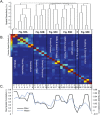Intrinsic network activity in tinnitus investigated using functional MRI
- PMID: 27091485
- PMCID: PMC4945432
- DOI: 10.1002/hbm.23204
Intrinsic network activity in tinnitus investigated using functional MRI
Abstract
Tinnitus is an increasingly common disorder in which patients experience phantom auditory sensations, usually ringing or buzzing in the ear. Tinnitus pathophysiology has been repeatedly shown to involve both auditory and non-auditory brain structures, making network-level studies of tinnitus critical. In this magnetic resonance imaging (MRI) study, two resting-state functional connectivity (RSFC) approaches were used to better understand functional network disturbances in tinnitus. First, we demonstrated tinnitus-related reductions in RSFC between specific brain regions and resting-state networks (RSNs), defined by independent components analysis (ICA) and chosen for their overlap with structures known to be affected in tinnitus. Then, we restricted ICA to data from tinnitus patients, and identified one RSN not apparent in control data. This tinnitus RSN included auditory-sensory regions like inferior colliculus and medial Heschl's gyrus, as well as classically non-auditory regions like the mediodorsal nucleus of the thalamus, striatum, lateral prefrontal, and orbitofrontal cortex. Notably, patients' reported tinnitus loudness was positively correlated with RSFC between the mediodorsal nucleus and the tinnitus RSN, indicating that this network may underlie the auditory-sensory experience of tinnitus. These data support the idea that tinnitus involves network dysfunction, and further stress the importance of communication between auditory-sensory and fronto-striatal circuits in tinnitus pathophysiology. Hum Brain Mapp 37:2717-2735, 2016. © 2016 The Authors Human Brain Mapping Published by Wiley Periodicals, Inc.
Keywords: auditory; fMRI; functional connectivity; hearing loss; striatum; thalamus.
© 2016 The Authors Human Brain Mapping Published by Wiley Periodicals, Inc.
Figures





Similar articles
-
Default mode, dorsal attention and auditory resting state networks exhibit differential functional connectivity in tinnitus and hearing loss.PLoS One. 2013 Oct 2;8(10):e76488. doi: 10.1371/journal.pone.0076488. eCollection 2013. PLoS One. 2013. PMID: 24098513 Free PMC article.
-
Abnormal resting-state functional connectivity study in unilateral pulsatile tinnitus patients with single etiology: A seed-based functional connectivity study.Eur J Radiol. 2016 Nov;85(11):2023-2029. doi: 10.1016/j.ejrad.2016.09.011. Epub 2016 Sep 13. Eur J Radiol. 2016. PMID: 27776655
-
Connectivity graph analysis of the auditory resting state network in tinnitus.Brain Res. 2012 Nov 16;1485:10-21. doi: 10.1016/j.brainres.2012.05.006. Epub 2012 May 10. Brain Res. 2012. PMID: 22579727
-
Using resting state functional connectivity to unravel networks of tinnitus.Hear Res. 2014 Jan;307:153-62. doi: 10.1016/j.heares.2013.07.010. Epub 2013 Jul 26. Hear Res. 2014. PMID: 23895873 Review.
-
Functional Brain Regions Linked to Tinnitus Pathology and Compensation During Task Performance: A Systematic Review.Otolaryngol Head Neck Surg. 2023 Dec;169(6):1409-1423. doi: 10.1002/ohn.459. Epub 2023 Jul 31. Otolaryngol Head Neck Surg. 2023. PMID: 37522290
Cited by
-
Chronic Tinnitus Exhibits Bidirectional Functional Dysconnectivity in Frontostriatal Circuit.Front Neurosci. 2019 Dec 6;13:1299. doi: 10.3389/fnins.2019.01299. eCollection 2019. Front Neurosci. 2019. PMID: 31866810 Free PMC article.
-
A large-scale diffusion imaging study of tinnitus and hearing loss.Sci Rep. 2021 Dec 3;11(1):23395. doi: 10.1038/s41598-021-02908-6. Sci Rep. 2021. PMID: 34862447 Free PMC article.
-
Disrupted local neural activity and functional connectivity in subjective tinnitus patients: evidence from resting-state fMRI study.Neuroradiology. 2018 Nov;60(11):1193-1201. doi: 10.1007/s00234-018-2087-0. Epub 2018 Aug 29. Neuroradiology. 2018. PMID: 30159629
-
Sensory overamplification in layer 5 auditory corticofugal projection neurons following cochlear nerve synaptic damage.Nat Commun. 2018 Jun 25;9(1):2468. doi: 10.1038/s41467-018-04852-y. Nat Commun. 2018. PMID: 29941910 Free PMC article.
-
Resting-State Brain Abnormalities in Chronic Subjective Tinnitus: A Meta-Analysis.Front Hum Neurosci. 2017 Jan 24;11:22. doi: 10.3389/fnhum.2017.00022. eCollection 2017. Front Hum Neurosci. 2017. PMID: 28174532 Free PMC article.
References
-
- Allen EA, Erhardt EB, Damaraju E, Gruner W, Segall JM, Silva RF, Havlicek M, Rachakonda S, Fries J, Kalyanam R, Michael AM, Caprihan A, Turner JA, Eichele T, Adelsheim S, Bryan AD, Bustillo J, Clark VP, Feldstein Ewing SW, Filbey F, Ford CC, Hutchison K, Jung RE, Kiehl KA, Kodituwakku P, Komesu YM, Mayer AR, Pearlson GD, Phillips JP, Sadek JR, Stevens M, Teuscher U, Thoma RJ, Calhoun VD (2011): A baseline for the multivariate comparison of resting‐state networks. Front Syst Neurosci 5:2. - PMC - PubMed
-
- Behrens TEJ, Johansen‐Berg H, Woolrich MW, Smith SM, Wheeler‐Kingshott CAM, Boulby PA, Barker GJ, Sillery EL, Sheehan K, Ciccarelli O, Thompson AJ, Brady JM, Matthews PM (2003): Non‐invasive mapping of connections between human thalamus and cortex using diffusion imaging. Nat Neurosci 6:750–757. - PubMed
-
- Boyen K, Langers DRM, de Kleine E, van Dijk P (2013): Gray matter in the brain: Differences associated with tinnitus and hearing loss. Hear Res 295:67–76. - PubMed
Publication types
MeSH terms
Grants and funding
LinkOut - more resources
Full Text Sources
Other Literature Sources
Medical
Miscellaneous

